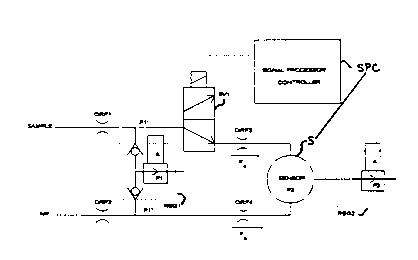Some of the information on this Web page has been provided by external sources. The Government of Canada is not responsible for the accuracy, reliability or currency of the information supplied by external sources. Users wishing to rely upon this information should consult directly with the source of the information. Content provided by external sources is not subject to official languages, privacy and accessibility requirements.
Any discrepancies in the text and image of the Claims and Abstract are due to differing posting times. Text of the Claims and Abstract are posted:
| (12) Patent: | (11) CA 2215875 |
|---|---|
| (54) English Title: | APPARATUS FOR HIGH OXYGEN CONCENTRATION MEASUREMENT USING LIMITING CURRENT OXYGEN SENSOR |
| (54) French Title: | APPAREIL DE MESURE DES FORTES CONCENTRATIONS D'OXYGENE AU MOYEN D'UN DETECTEUR D'OXYGENE A COURANT LIMITEUR |
| Status: | Expired and beyond the Period of Reversal |
| (51) International Patent Classification (IPC): |
|
|---|---|
| (72) Inventors : |
|
| (73) Owners : |
|
| (71) Applicants : |
|
| (74) Agent: | MARKS & CLERK |
| (74) Associate agent: | |
| (45) Issued: | 2002-06-04 |
| (22) Filed Date: | 1997-09-18 |
| (41) Open to Public Inspection: | 1998-08-05 |
| Examination requested: | 1999-01-07 |
| Availability of licence: | N/A |
| Dedicated to the Public: | N/A |
| (25) Language of filing: | English |
| Patent Cooperation Treaty (PCT): | No |
|---|
| (30) Application Priority Data: | ||||||
|---|---|---|---|---|---|---|
|
A gas analysis apparatus using multiple orifices of
preselected sizes to attain a calculated gas mixing ratio for
diluting an oxygen sample to a concentration less than 95% prior to
application to a limiting current oxygen sensor. The apparatus
comprises a regulator for regulating the pressures of incoming
flows of air and oxygen sample to be measured, a valve for allowing
the concentration of the air sample to oxygen sample to be
measured, and a system for calculating the air sample/oxygen sample
mixing ratio based on the known air sample concentration and then,
based on the known air concentration and calculated mixing ratio,
calculating the unknown sample concentration from the output of the
oxygen sensor.
Note: Claims are shown in the official language in which they were submitted.
Note: Descriptions are shown in the official language in which they were submitted.

2024-08-01:As part of the Next Generation Patents (NGP) transition, the Canadian Patents Database (CPD) now contains a more detailed Event History, which replicates the Event Log of our new back-office solution.
Please note that "Inactive:" events refers to events no longer in use in our new back-office solution.
For a clearer understanding of the status of the application/patent presented on this page, the site Disclaimer , as well as the definitions for Patent , Event History , Maintenance Fee and Payment History should be consulted.
| Description | Date |
|---|---|
| Time Limit for Reversal Expired | 2007-09-18 |
| Letter Sent | 2006-09-18 |
| Inactive: IPC from MCD | 2006-03-12 |
| Inactive: IPC from MCD | 2006-03-12 |
| Letter Sent | 2003-12-02 |
| Inactive: Multiple transfers | 2003-10-30 |
| Grant by Issuance | 2002-06-04 |
| Inactive: Cover page published | 2002-06-03 |
| Pre-grant | 2002-03-21 |
| Inactive: Final fee received | 2002-03-21 |
| Notice of Allowance is Issued | 2002-02-12 |
| Letter Sent | 2002-02-12 |
| Notice of Allowance is Issued | 2002-02-12 |
| Inactive: Approved for allowance (AFA) | 2002-01-23 |
| Amendment Received - Voluntary Amendment | 2001-12-14 |
| Amendment Received - Voluntary Amendment | 1999-03-05 |
| Letter Sent | 1999-02-02 |
| Request for Examination Requirements Determined Compliant | 1999-01-07 |
| All Requirements for Examination Determined Compliant | 1999-01-07 |
| Request for Examination Received | 1999-01-07 |
| Inactive: Correspondence - Transfer | 1998-10-01 |
| Inactive: Single transfer | 1998-09-15 |
| Application Published (Open to Public Inspection) | 1998-08-05 |
| Inactive: IPC assigned | 1997-12-09 |
| Classification Modified | 1997-12-09 |
| Inactive: IPC assigned | 1997-12-09 |
| Inactive: First IPC assigned | 1997-12-09 |
| Inactive: Courtesy letter - Evidence | 1997-12-02 |
| Inactive: Filing certificate - No RFE (English) | 1997-11-24 |
| Filing Requirements Determined Compliant | 1997-11-24 |
| Application Received - Regular National | 1997-11-24 |
There is no abandonment history.
The last payment was received on 2001-06-14
Note : If the full payment has not been received on or before the date indicated, a further fee may be required which may be one of the following
Please refer to the CIPO Patent Fees web page to see all current fee amounts.
| Fee Type | Anniversary Year | Due Date | Paid Date |
|---|---|---|---|
| Application fee - standard | 1997-09-18 | ||
| Registration of a document | 1997-09-18 | ||
| Request for examination - standard | 1999-01-07 | ||
| MF (application, 2nd anniv.) - standard | 02 | 1999-09-20 | 1999-09-17 |
| MF (application, 3rd anniv.) - standard | 03 | 2000-09-18 | 2000-05-16 |
| MF (application, 4th anniv.) - standard | 04 | 2001-09-18 | 2001-06-14 |
| Final fee - standard | 2002-03-21 | ||
| MF (patent, 5th anniv.) - standard | 2002-09-18 | 2002-09-03 | |
| MF (patent, 6th anniv.) - standard | 2003-09-18 | 2003-09-03 | |
| Registration of a document | 2003-10-30 | ||
| MF (patent, 7th anniv.) - standard | 2004-09-20 | 2004-09-01 | |
| MF (patent, 8th anniv.) - standard | 2005-09-19 | 2005-09-01 |
Note: Records showing the ownership history in alphabetical order.
| Current Owners on Record |
|---|
| LITTON SYSTEMS, INC. |
| CARLETON LIFE SUPPORT SYSTEMS INC. |
| Past Owners on Record |
|---|
| TUAN QUOC CAO |